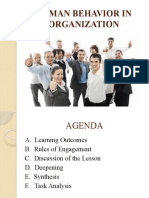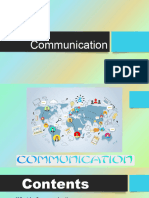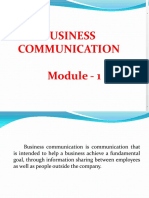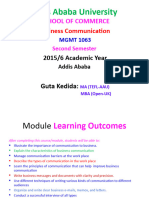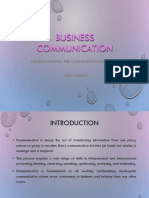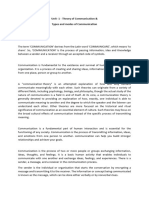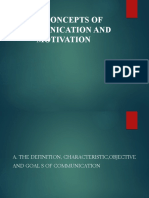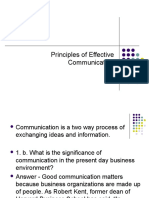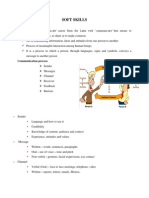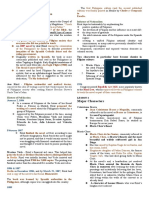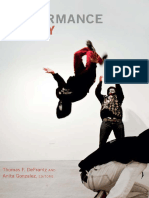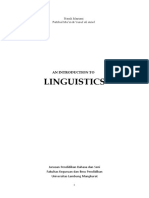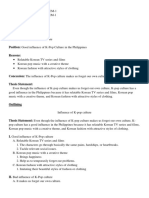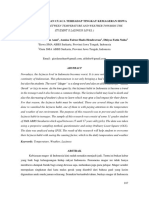Class: BSc Sem 5
Subject : Business communication
Chapter: Unit 1 Chapter 1
Chapter Name: Introduction to communication
1
�Today’s Agenda
1. Define communication
2. Simple communication model
3. Contemporary real – life model
4. Communication context
5. Elements of communication
6. Types of communication
7. Characteristics of communication
8. Barriers to communication
9. Impact of poor communication in organisations
10. Make communication effective
2
�1 Define Communication
Communication is the exchange of information and feelings in which human beings engage whenever they come
together.
OR
Communication is a complex process of verbally and non-verbally sharing knowledge, interests, opinions, feelings
and ideas with any other person or a group of persons.
3
�1 Define Communication
• Communication is something everyone does irrespective of age, social status, academic achievement or
financial standing.
• Studies suggest that 75% to 80% of their waking time in communication.
• An essential characteristics of communication is that it is a social affair defined by the socio – cultural and
linguistic context to which the person belongs.
4
�2 Simple Communication Model
Encode Decode
Sender Message Medium Channel Receiver
Feedback
5
�3 Contemporary Real – Life Model of
Communication
• Communication is not just a one-time activity of transmitting the message and receiving the response of
that message. The entire process takes place within a specific communication environment or a common
frame of reference between the sender & the receiver.
• Communication in real life is not a mechanical process, which ends with the receiver receiving the
message and acting accordingly. It becomes a circular, cyclic and non- linear dynamic process with each
message, each experience adding to the process. (explained with the help of a diagram on the following
page)
6
�3 Real – Life Communication Model
Sender Message Medium Channel Receiver
Sender Message Medium Channel Receiver
7
�4 Communication context
• Communication takes place within a context. Any communication context includes the national culture,
organizational culture, the immediate situation and the personality of the sender and the receiver.
• The setting, the physical environment, provides the backdrop to a message and determines the nature of
communication.
• Words take on different meanings depending on the situation in which they are spoken.
• The attitudes, opinions, emotional level, educational qualifications and past experiences decide the nature
and process of communication.
• In order to make communication effective, we need to understand and adapt ourselves to the context we
communicate in.
8
�5 Elements of communication
• Sender – One who initiates the process and works as the source.
• Message – It is a properly designed and developed piece of information, which needs to be
communicated to the receiver.
• Medium – Medium is the mode selected by the sender to send the message.
• Channel – Channel is a carrier to convey the message.
• Receiver – Receiver interprets the message and tries to get the intended meaning as far as possible.
• Feedback – The receiver’s perception of the message produces a response that is called feedback.
9
�6 Types of communication
• Intrapersonal communication - Intrapersonal communication can be defined as communication with one's
self, and that may include self-talk, acts of imagination and visualization, and even recall and memory.
• Interpersonal communication - Interpersonal communication refers to communication between two or
more people. It involves the exchange of messages, ideas, and information between individuals.
• Group communication - Group communication is the act of sending and receiving messages to multiple
members of a group. In a business environment, groups often use this type of communication to exchange
ideas, determine goals and motivate other members.
• Mass communication - Mass communication is the process of imparting and exchanging information
through mass media to large population segments.
• Digital communication - Digital communication is the use of online tools like email, social media
messaging and texting to reach other individuals or a specific audience in order to share a message.
10
�7 Characteristics of communication
1. Communication is a learned skill – Human beings are born with the physical ability to talk, but we must
learn to speak well and communicate effectively. The study of communications as an academic discipline
provides the theoretical context in which these skills can be sharpened and also make us learn how to
apply them in real-life environment.
2. Communication is not only “Words” - Communication can take place not only by using verbal messages.
Much can be said through nonverbal or wordless messages, such as signs, cues and symbols. Facial
expressions, body language, eye contact, gestures, touch, tone of voice, colour, space and timing are
some of the cues and symbols of non-verbal communication.
3. Communication can be “Improved” - The efficiency with which we express our views and share our
thoughts with others can be developed and constantly improved. Feedback, an important element of
process of communication, makes us aware of the gaps in our verbal and non-verbal communication
patterns.
11
�7 Characteristics of communication
4. Communication is about Relationships - The basic purpose of any communication is generally assumed to
be conveying information and getting our message across as clearly as possible. It is also used to
persuade, to convince, to motivate, to inspire and to entertain. However, the ultimate purpose of
communication is to develop rapport, generate goodwill, establish bond and build relationships.
5. Communication exercises an Influence over Others - During the process of interaction with others, we
exercise influence over others. This influence may be direct or indirect, conscious or unconscious, subtle
or apparent.
12
�8 Barriers to communication
Sender – oriented Barriers Receiver – Oriented Barriers
• Poor expression • Poor listening
• Selecting wrong medium or channel • Retention ability
• Semantic Barrier • Analysing Information
• Quantity of Information • Indifference
• Ego • Conflicting information
• Prejudices • Arguments
13
�9 Impact of poor communication in organizations
1. Increased absence - When employees are not well informed, it affects the satisfaction they derive from
the workplace. Due to low satisfaction, employees do not prefer going to work. Hence, the rate of
employee absence increases in case of inefficient communication in the workplace.
2. Low productivity - Productivity of an employee depends on the information available. If the employee
does not have sufficient information, the quality of work is bound to get affected. Therefore, employee
productivity is directly proportional to the efficiency of communication.
3. Retention of employees - Poor communication leads to misinterpretation of information among
employees and eventually leads to dissatisfaction. Replacing an employee is costly and hurts the finances
of a company. Therefore, it is of utmost significance to communicate effectively with the employees to
retain them in the company as they form an important constituency of the company.
14
�9 Impact of poor communication in organizations
4. Customer satisfaction – Poor communication has a dual impact on customer service. Ineffective
communication results in lack of required information at the employee's end, and the employee is not
able to do the work efficiently. Secondly, the customer gets dissatisfied after the conversation with the
employee it communication is not efficient, thus harming the company's reputation.
5. Shareholder return - Shareholder return is influenced by market trends and shows a cyclical pattern. It the
company invests in effective communication, it is able to maintain market reputation and earn revenue.
Therefore, shareholder returns will also increase.
15
�10 Make communication effective
• Overcome filters – Filters are complex and appear in a variety of ways. To overcome these filters, efforts
should be made to discover its source. Once the source of the filter has been identified, steps can be taken
to overcome it. After that, constant conscious effort and self-discipline are required.
• Understand the Receiver - The main aim of any communication is to develop understanding between the
sender and the receiver. Putting the audience at the heart of any communication effort is the best strategy
for success.
• Ignore External Noise - Noise as a barrier is not difficult to overcome since it requires a proper
management of resources and good organisational skills. Just the awareness of its existence by either the
sender or the receiver of a message can help to improve the communication flow.
• Send Appropriate Non – verbal Signals - Communication competence requires that we send non-verbal
signals that are consistent with the verbal messages and appropriate with the context.
16
�10 Make communication effective
• Select the Right Channel - In any given communication context, the chance of miscommunication can be
minimised if appropriate channel is selected for conveying the message. The selected channel in a
particular situation should correlate with the feedback requirements.
• Give Timely Feedback - Feedback is receiver's response to the message. Without it, the sender cannot
know whether the recipient has received the entire message and grasped its intent. This also provides an
opportunity for suggestion and criticism.
• Be Culturally Sensitive - Behavioural patterns differ from culture to culture.
• Be Emotionally Intelligent - While a moderate level of emotions makes the message effective, one should
avoid being emotionally involved with the whole communication context. Thereby, one can creatively
manage stress and challenges, communicate well with others and display trust, empathy and confidence.
Losing control of emotions leads to confusion, isolation and negativity.
17
�10 Make communication effective
• Make it Ethical - Communication is an effort to engage other persons; it is a way of reaching others with
information, ideas, emotions and values with a definite goal in mind. As we have seen, communication has
the power to achieve positive or negative effects. It can shape the attitude of the people involved and,
therefore, influence their behaviour and decisions. Effective communicators need to develop the sensitivity
required to send and receive messages that are accurate and appropriate in a given context. Being ethical in
communication implies that we decide between the right and the good.
18





